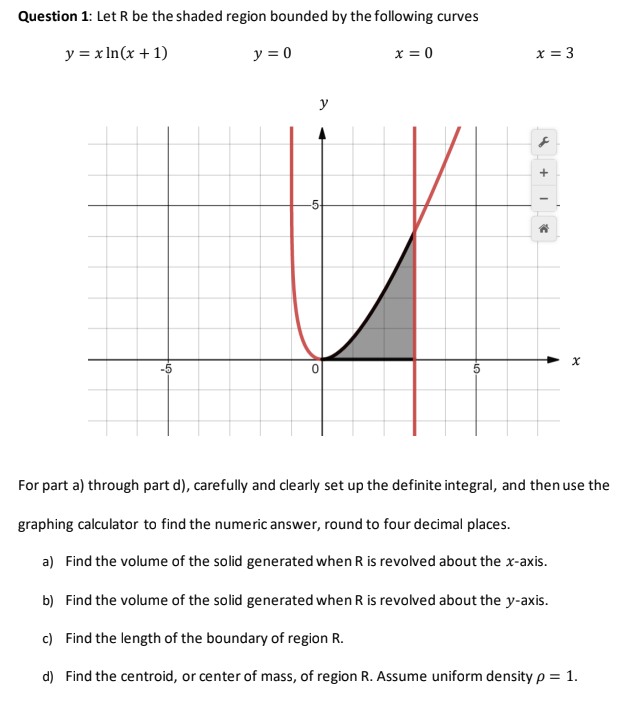Question 1: Let R be the shaded region bounded by the following curves y = x In(x + 1) y = 0 x = 0 x = 3 y -5- For part a) through part d), carefully and clearly set up the definite integral, and then use the graphing calculator to find the numeric answer, round to four decimal places. a) Find the volume of the solid generated when R is revolved about the x-axis.
Question 1: Let R be the shaded region bounded by the following curves y = x In(x + 1) y = 0 x = 0 x = 3 y -5- For part a) through part d), carefully and clearly set up the definite integral, and then use the graphing calculator to find the numeric answer, round to four decimal places. a) Find the volume of the solid generated when R is revolved about the x-axis.
Elementary Geometry For College Students, 7e
7th Edition
ISBN:9781337614085
Author:Alexander, Daniel C.; Koeberlein, Geralyn M.
Publisher:Alexander, Daniel C.; Koeberlein, Geralyn M.
Chapter10: Analytic Geometry
Section10.1: The Rectangular Coordinate System
Problem 41E: Find the exact lateral area of each solid in Exercise 40. Find the exact volume of the solid formed...
Related questions
Question
! show all work for part (a)

Transcribed Image Text:Question 1: Let R be the shaded region bounded by the following curves
y = x In(x + 1)
y = 0
x = 0
x = 3
y
For part a) through part d), carefully and clearly set up the definite integral, and then use the
graphing calculator to find the numeric answer, round to four decimal places.
a) Find the volume of the solid generated when R is revolved about the x-axis.
b) Find the volume of the solid generated when R is revolved about the y-axis.
c) Find the length of the boundary of region R.
d) Find the centroid, or center of mass, of region R. Assume uniform density p = 1.
Expert Solution
This question has been solved!
Explore an expertly crafted, step-by-step solution for a thorough understanding of key concepts.
Step by step
Solved in 2 steps with 2 images

Recommended textbooks for you

Elementary Geometry For College Students, 7e
Geometry
ISBN:
9781337614085
Author:
Alexander, Daniel C.; Koeberlein, Geralyn M.
Publisher:
Cengage,

Holt Mcdougal Larson Pre-algebra: Student Edition…
Algebra
ISBN:
9780547587776
Author:
HOLT MCDOUGAL
Publisher:
HOLT MCDOUGAL

Elementary Geometry For College Students, 7e
Geometry
ISBN:
9781337614085
Author:
Alexander, Daniel C.; Koeberlein, Geralyn M.
Publisher:
Cengage,

Holt Mcdougal Larson Pre-algebra: Student Edition…
Algebra
ISBN:
9780547587776
Author:
HOLT MCDOUGAL
Publisher:
HOLT MCDOUGAL